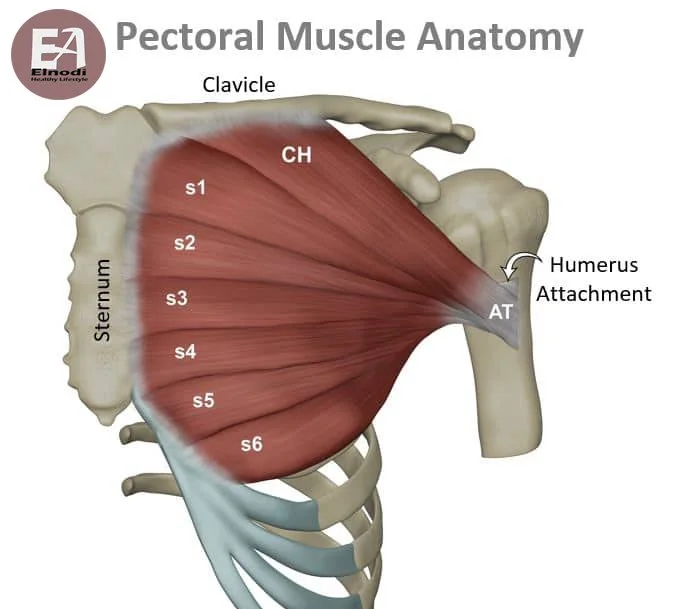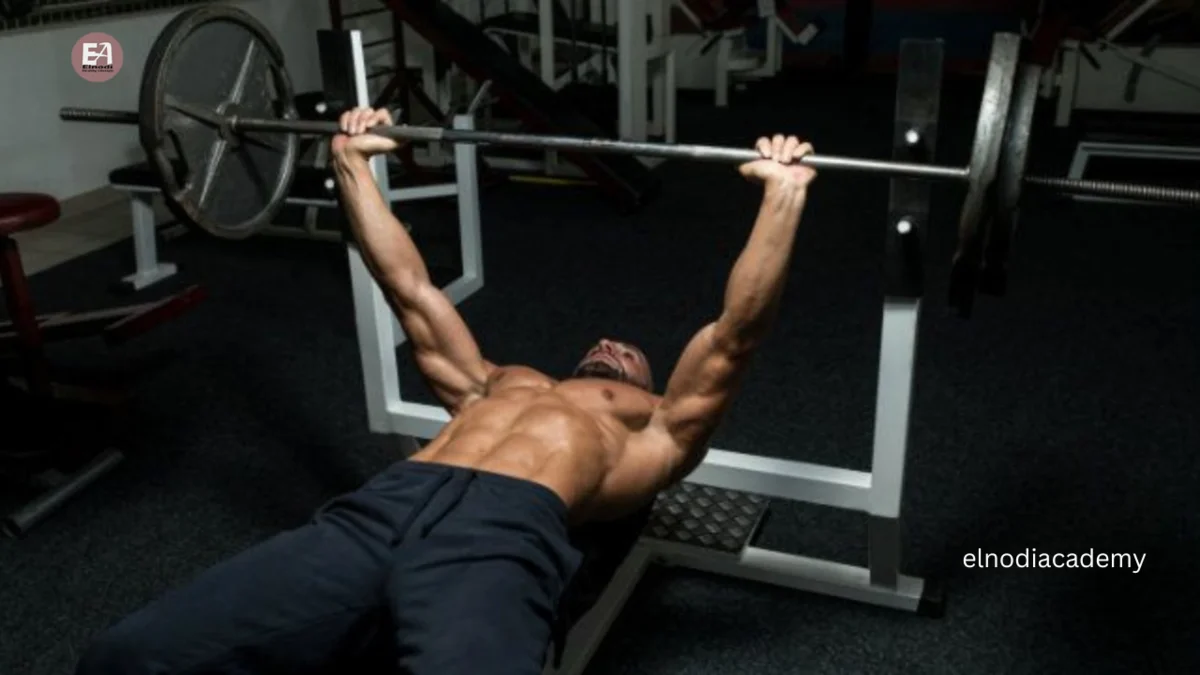The Barbell flat Bench Press is a great exercise for building muscle and strength, That can help you build muscle and strength quickly.
The Barbell flat Bench Press is a challenging exercise, but it is also a safe and effective exercise when performed correctly. If you are new to weightlifting, it is important to start with a light weight and gradually increase the weight as you get stronger. It is also important to use proper form to avoid injury.
what is Barbell flat Bench Press?
The flat bench press with a barbell is a compound exercise that works the chest, triceps, and front deltoids. For good reason, it is one of the most popular exercises in the gym. It is an excellent approach to increase upper-body muscle and strength.
To do the barbell flat bench press, you will need a barbell and a bench. Lie on the bench with your feet flat on the floor and your knees bent. Grip the barbell with an overhand grip that is slightly wider than shoulder-width apart. Lower the barbell to your chest, keeping your elbows close to your sides. Press the barbell back up to the starting position.
Benefits of a Bench Press
The bench press is a complex exercise that works the pectoralis major (chest), anterior deltoids (shoulder), and triceps brachii (upper arm). It increases strength while also increasing muscle growth (hypertrophy).
Muscle growth is not only desired by bodybuilders but also provides benefits for everyone as muscle mass typically declines with age. The bench press is a functional exercise that helps you more easily perform daily activities that require pushing or carrying.
For athletes who primarily employ pulling muscles, the bench press can assist restore muscular balance. Wrestlers, rock climbers, and swimmers are examples of this. The barbell bench press, together with the deadlift and squat, is a competitive lift in the sport of powerlifting.
muscle worked Barbell flat Bench Press

The barbell flat bench press is a compound exercise that targets several upper-body muscular groups, including:
Pectoralis major: The pectoralis major muscle is the largest in the chest. It is the primary muscle recruited during the barbell flat bench Press and is responsible for moving the arm across the chest.
Triceps brachii: The triceps brachii is the muscle on the back of the upper arm. It is responsible for extending the arm and is a secondary muscle worked during the Barbell flat Bench Press.
Anterior deltoids: The anterior deltoids are the front head of the deltoids, which are shoulder muscles. They are a secondary muscle recruited during the Barbell flat Bench Press and are responsible for lifting the arm in front of the body.
Serratus anterior: The serratus anterior is a muscle in the chest that helps to stabilize the shoulder blade. It is worked during the Barbell flat Bench Press to help keep the shoulder blades down and back.
Latissimus dorsi: The latissimus dorsi is a big muscle in the back. It is not a primary muscle worked during the barbell flat Bench Press, but it can be used to assist in lifting the weight.
Trapezius: The trapezius muscle goes down the back of the neck and shoulders. It is not a primary muscle worked during the Barbell Flat Bench Press, but it can be used to assist in lifting the weight.
The Barbell flat Bench Press is a great exercise for building muscle and strength in the upper body. It is a difficult workout, but when done correctly, it is also a safe and effective exercise. If you’re seeking a hard and effective workout to increase upper-body muscle and strength, the Barbell flat Bench Press is a terrific choice.
How to do Barbell flat Bench Press
Barbell flat Bench Press Instructions

- Lie flat on a bench and set your hands just outside of shoulder width.
- Pinch your shoulder blades together and drive them into the bench to set them.
- Take a deep breath and allow your spotter to assist you with the lift-off to keep your upper back taut.
- Allow the weight to settle and keep your upper back taut after lifting off.
- Inhale and slowly lower the bar by freeing the elbows.
- Straighten the barbell to the base of the sternum (breastbone) and touch the chest.
- Press yourself into the bench, drive your feet into the floor for leg drive, and extend your elbows to bring the barbell back up in a straight line.
- Repeat for the desired number of repetitions.
Barbell Flat Bench Press Tips
- Technique comes first, then weight – no one cares how much you bench if you get hurt.

- Keep the bar in line with your wrist and elbows and ensure it travels in a straight line. In order to keep the wrist straight, try to position the barbell as low in the palm as possible while still being able to wrap the thumb.
- Stop each repetition slightly short of lockout at the top if you want to keep extra tension in the triceps and chest.
- Don’t be concerned about excessive elbow tucking; a lot of this advice comes from geared lifters wearing suits. Some lifters may benefit from a tiny tuck on the way down, but others can employ Greg Nuckols’ brilliant cue “flare and push” to get the same result.
- Arching may be beneficial depending on your goals, but make sure that the majority of your arch comes from your mid to upper back and not your lower back. If your lower back cramps as you prepare to lift, you’re out of position and putting yourself in danger of injury.
- The bar should touch your chest with every single repetition. If you want to overload specific ranges of motion, look into board presses or accommodating resistance with chains or bands.
- As the bar descends, aim for your sternum (breastbone) or slightly below depending upon the length of your upper arm in order to promote a linear bar path.
- Intermediate and intermediate lifters may utilize a thumbless or “suicide” grip, but for the majority of lifters, learning to bench with the thumb wrapped around the bar is preferable at first.
- Fight to the urge to allow the wrists to roll back into extension, think about rolling your knuckles toward the ceiling.
- Experiment with grip breadth; if you have longer arms, a somewhat wider grasp may be required. If you experience pressure in the front of your shoulder during the exercise, you may need to widen your grip, enhance scapular retraction, or reduce the range of motion slightly with exercises like floor or board presses.
- Squeeze the bar as tightly as possible to help enhance shoulder stability.
- Some lifters prefer to tuck their toes while others prefer to keep their feet flat to maximize leg drive; experiment with both and discover which one feels better and allows for more power production.
- Ensure the shoulder blades remain retracted and don’t allow them to change position as you press.
- The bar should descend under control and touch the lifter’s chest – no bouncing or excess momentum.
- Think about trying to push yourself away from the bar instead of pushing the bar off of you.
- Tightness in the upper back should be one of your top focuses throughout the lift.
- Ideally, use a spotter to help assist with the lift-off in order to maintain tension through the upper back.
- Maintain silent feet throughout the lift and use leg drive to support the pelvis by driving your feet into the floor and tightening your glutes.
- Focus on pulling the bar apart or trying to “bend the bar” in order to activate some of the intrinsic stabilizers in the shoulder.
- The glutes and shoulder blades should maintain contact with the bench throughout the entirety of the movement.
- Dave Tate’s benching bible is a wonderful place to start if you want to learn more about the subtleties of benching.
Common Mistakes

Avoid these common errors to keep your bench press safe and effective.
Improper Grip Width
Your grip on the bar should be wide enough to keep your elbows at right angles (at a minimum) and your forearms perpendicular to the ground. You risk damaging your pectoral muscles if your grasp is too wide and your elbows are excessively stretched out.
Moving Bar Over the Mouth or Neck
When racking or unracking the bar, make sure the path is not too low—over the mouth and neck region. This implies you should shift the weight to and from the rack with your arms outstretched, rather than low across your neck and face.
Locking Elbows Suddenly
Contrary to some weightlifting safety advice, you can “lock out” your elbows when doing a bench press. The key to making this action safe is to not lock the elbows out suddenly or explosively.
Incorrect Thumb Position
Another grip-based mistake involves the thumb position. Your hand grip should be overhand with the thumbs placed under the bar and across the top of the fingers. Don’t place the thumbs behind the bar or locked beneath the fingers.
Pushing Head Into Bench
For stability, keep your head level on the bench and your feet flat on the floor, but don’t push your head into the bench to help with the lift—firm up the neck muscles instead.
Arching Back and Lifting Buttocks
During the press, keep your buttocks flat on the bench. Don’t arch your back so far that your buttocks lift off the bench like a powerlifter.





